 |
 |
| Korean J Intern Med > Volume 18(1); 2003 > Article |
|
Abstract
Background
Liver cirrhosis is a diffuse hepatic fibrosis and nodule formation. The transforming growth factor-╬▓1 (TGF-╬▓1) and interleukin-10 (IL-10) are very important cytokines in hepatic fibrogenesis. The aim of this study was to examine the relationship between the changes of the serum cytokines and morphological changes following common bile duct ligation in experimental rats.
Methods
Common bile ducts of fifty male Sprague-Dawley rats were ligated and seven male rats were set aside as controls. Five rats each were sacrificed in 1, 2, 4, 6, 8, and 10 experimental weeks. Light microscopic studies and liver function tests were performed during the above experimental weeks. The levels of serum TGF-╬▓1 and IL-10 were analyzed by ELISA. Also, alpha smooth muscle actin (╬▒-SMA) immunohistochemical stains were performed.
Results
On the eighth week after common bile duct ligation, most hepatic lobular areas had been replaced by proliferated bile ducts and fibrous tissue (typical biliary cirrhosis). Serum TGF-╬▓1 levels between the control group and the common bile duct ligation group showed statistically significant changes. The ╬▒-SMA was stained at proliferated bile ducts. These findings were correlated with each other.
Liver cirrhosis is a chronic liver disease caused by viruses, alcohol, various drugs and congenital disease. Complications of this disease include gastrointestinal bleeding, ascites, hepatic failure and hepatocellular carcinoma. However, there is no definite treatment of this disease. Until 1980, in Korea, hepatitis B was a prominent cause of liver cirrhosis, but frequency was decreased due to life-style changes and vaccination, especially for the young1). However, alcoholic cirrhosis has increased2). Hepatocellular carcinoma associated with liver cirrhosis is an important cause of death in Korea3). Therefore, an understanding of the pathogenesis of liver cirrhosis and fibrosis is an important task in the fight against hepatocellular carcinoma.
Liver fibrosis causes scar formation regardless of the various causes and this process is similar in the other organs. Fibrosis of the liver is increased in the extracellular matrix and results in loss of liver parenchymal cells. Various factors, such as cell and extracellular matrix and cytokines, are known in the process of hepatic fibrosis. Hepatic stellate cells (Ito cell or lipocyte) are important cells that secrete the extracellular matrix. These cells are in a resting state normally, but are activated when the cytokines or oxidative stress are given. Activated hepatic stellate cells increase the secretion and accumulation of extracellalar matrix surrounding the space of Disse4, 5).
Cytokines which activate hepatic stellate cells are a transforming growth factor -beta 1 (TGF-╬▓1), platelet-derived growth factor (PDGF), fibroblast growth factor (FGF) and endothelin-1 (ET-1). TGF-╬▓1 is a key cytokine that initiates and terminates tissue repair and development of hepatic fibrosis6). In fact, TGF-╬▓1 is the most potent mediator in fibrogenic mechanism. TGF-╬▓1 plays an important role in the production of extracellular matrix deposition and prevention of the degradation of extracellular proteins by enhancing production of fibronectin and collagen in the liver. Excessive or sustained production of TGF-╬▓1 is an important mediator of liver fibrosis7, 8).
Interleukin-10 is a potent anti-inflammatory and anti-fibrotic cytokine. This cytokine increases in the early stage of hepatic stellate cell activation and the abscence of this leads to enhanced fibrogenesis9, 10).
In this report, we demonstrate the relationship between the morphological changes and serum cytokines in liver cirrhosis induced by common bile duct ligation in rats.
Four-week old male Sprague -Dawley rats, about 200 g, were used (kindly supplied by Biogenomics Co, Charles River Technology License). The experimental group (cholestatic liver injury group by common bile duct ligation) totalled fifty rats and the control group was seven rats. All animals received humane care in compliance with the Guide for the ŌĆ£Care and Use of Laboratory AnimalsŌĆØ prepared by the Natural Institute of Health (NIH Publication No. 85-23, revised 1996).
Cholestatic liver injury was induced in male rats by ligation and transection of the common bile duct. These animals were sacrificed during 12 weeks. Five rats were sacrificed every two weeks. Blood samples were obtained from cardiac punctures under ketamin with xylazine (Rumpun, Seoul, Korea) anesthesia, and centrifuged at 10,000 g for 5 minutes after 1, 2, 4, 6, 7, 8, 10 experimental week. Serum was stored at ŌłÆ70┬░C. Liver function tests were performed on each experimental week (total protein, albumin, aspartate aminotransferase, alanine aminotransferase, alkaline phosphatase, gamma glutamyl transpeptidase); and serum transforming growth factor-╬▓1 (TGF-╬▓1) and interleukin-10 (IL-10) concentration were analyzed using the enzyme-linked immunosorbent assay kit (Quantikine, R&D System).
Assay procedures of TGF-╬▓1 were as follows. Prepare all reagents, working standards and activated samples as instructed. Add 200 ╬╝L standard or activated sample to each well and incubate for 3 hours. Aspirate and wash 3 times. Add 200 ╬╝L conjugate to each well and incubate for 1.5 hours. Aspirate and wash 3 times. Add 200 ╬╝L substrate solution to each well and incubate for 20 minutes. Add 50 ╬╝L stop solution to each well and read at 450 nm within 30 minutes. Serum IL-10 concentration assay was as follows. Add 50 ╬╝L assay diluting agent to the center of each well. Add 50 ╬╝L standard, control, or sample to the center of each well, and incubate for 2 hours. Aspirate and wash each well 5 times. Add 100 ╬╝L. conjugate to each well and incubate for 2 hours. Aspirate and wash each well 5 times. Add 100 ╬╝L substrate solution to each well and incubate for 30 minutes. Add 100 ╬╝L stop solution to each well and read optical density at 450 nm.
Liver specimens of experimental rats were obtained and routinely fixed in 10% formalin and embedded in paraffin blocks. Using thin tissue section, hematoxylin-eosin (HE) and Masson trichrome stains were performed. Alpha smooth muscle actin has been widely used to detect stellate cell activation. Incubate with monoclonal antibodies for alpha smooth muscle actin (anti-SMA) (Nichirei Co., Tokyo, Japan). After rinsing, tissues were incubated with a biotinylated rabbit antimouse IgG F (abŌĆ▓) fragment (DAKO Japan, Kyoto, Japan). Thereafter, sections were incubated in the avidin biotin complex (ABC) solution (Vectastatin, Burlingame, CA, USA)11).
A total of 11 rats died during the experimental periods. The cause of death was peritonitis in the common bile duct ligation group. There were no deaths in the control group.
Between the control group and the common bile duct ligated group, statistically significant changes of the serum liver enzymes were found in albumin, AST, ALT and alkaline phosphatase (Table 2).
Serum TGF-╬▓1 levels between the control group and the common bile duct ligation group showed statistically significant changes (p<0.05). The serum TGF-╬▓1 levels revealed high values from the sixth experimental week to the eighth experimental week. The serum IL-10 levels of the control and bile duct ligation group did not show statistically significant changes (Table 3).
The morphological changes of the common bile duct ligation group include bile duct proliferation and dilatation and inflamatory cell infiltration. By the eighth week after common bile duct ligation, most hepatic lobular areas were replaced by proliferated bile ducts and fibrous tissue (typical biliary cirrhosis). With respect to immunohistochemical stains, most hepatic lobular areas are replaced by proliferative bile ducts and ╬▒-SMA were stained after eighth experimental week. These findings are correlated with each other.
Liver cirrhosis is defined as the end stage liver disease and as an irreversible state characterized by regenerating nodule formation and diffuse fibrotic change12, 13). The causes of cirrhosis are varied and include viral infection, alcohol and chemical agents and birth metabolism error, but the end results are the same. The complications of cirrhosis are ascites, variceal bleeding, hepatic encephalopathy and hepatocellular carcinoma. It is essential to understand the hepatic fibrosis in liver cirrhosis. Hepatic stellate cells (previous called Ito cell, fat-storing or perisinusoidal cells) are fat-storing perisinusoidal cells and are importamt cells in hepatic fibrosis. Hepatic stellate cells are activated during liver cell injury, including acute and chronic liver disease and then white blood-cell chemoattractant releases the various cytokines and oxygen-free radicals. Also, activated stellate cells supply the type I collagen and extracellular matrix and these materials were accumulated in the space of Disse. These processes are the beginning of hepatic fibrosis14ŌĆō17).
Transforming growth factor ╬▓1 (TGF-╬▓1) is the most potent fibrogenic cytokine and plays an important role in the activation and regulation of hepatic stellate cells. It is known that TGF-╬▓1 is a regulatory cytokine in the growth and differentiation of cells and plays a pivotal role in the process of wound healing and fibrogenesis. TGF-╬▓1 is secreted from various cells including Kupffer cells, activated stellate cells and hepatocyte, and is related to the synthesis of fibronectin, type I collagen. TGF-╬▓1 increases in advanced fibrosis but is not expressed in normal liver tissue18ŌĆō20).
This study shows that serum TGF-╬▓1 level was higher in the common bile duct ligation group than in the control group. Similary, TGF-╬▓1 expression increases in CCL4 induced acute hepatic injury21).
In liver biopsy findings, bile ducts proliferate after bile duct ligation, and maximal proliferation is seen at the eighth experimental week. The changes of serum cytokines were compared with microscopic findings. Alpha smooth muscle actin is present in smooth muscle cells near the biliary structure and is a stained cytoskeletal structure in the hepatic stellate cell. The degree of ╬▒-SMA stain represents the extension of fibrosis, indirectly. In our study, TGF-╬▓1 level was correlated with the degree of ╬▒-SMA stain.
IL-10 is a potent anti-inflammatory cytokine that inhibits the synthesis of pro-inflammatory cytokines and it down-regulates superoxide synthesis22, 23). IL-10 increases in the early stage of stellate cell activation9). Expression of IL-10 in inflammatory tissue is related to the improvement of inflammation. IL-10 down-regulates the expression of type 1 collagen genes and up-regulates the matrix metalloprotease-1 (interstitial collagenase) and matrix collagenase-3 (stromelysin-1)24). Recently, it was found that IL-10 deficient knocked-out mice have more neutrophil infiltration and severe fibrosis after various hepatic injuries25ŌĆō28). Thus, IL-10 has an important role in hepatic fibrosis as an anti-fibrotic agent. A recent animal study showed that the expression of IL-10 mRNA increases in the early period in bile duct ligation rats29). In this study, serum concentration of IL-10 is highest at the first and second experimental weeks. Thereafter, serum concentration of IL-10 decreases. We assumed that IL-10 has a pivotal role in fibrosis as an anti-fibrotic agent, and that a therapeutic use of this cytokine can be expected. In conclusion, our findings were a long-term study compared with previous extrahepatic cholestatic study in rats, and several cytokines were involved, including TGF-╬▓1, IL-6. Especially, IL-10 may be involved in antifibrogenesis.
Figure┬Ā1.
Change of serum TGF-╬▓1 concentrations. The serum TGF-╬▓1 levels in the control (G-I) and common bile duct ligation group (G-II) show statistically significant changes.

Figure┬Ā2.
Change of serum interleukin-10 concentration. The serum interleukin levels in the control (G-I) and common bile duct ligation group (G-II) at early experimental weeks show statistically significant changes.
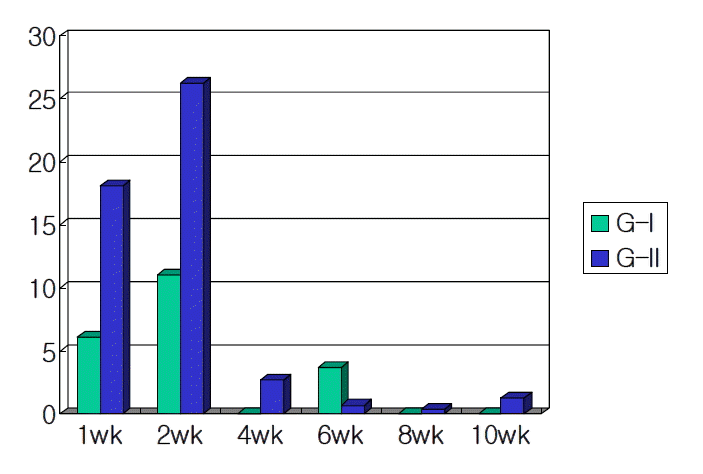
Figure┬Ā3.
Ascites and significant cysts were found the fourth week after common bile duct ligation, gross findings.
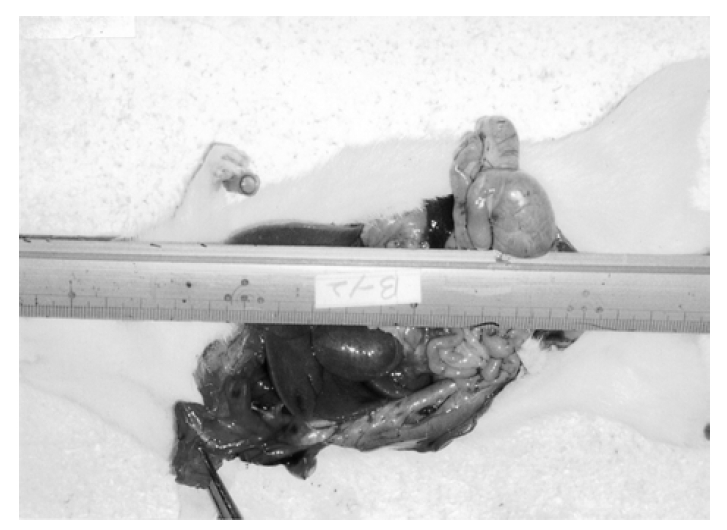
Figure┬Ā4.
Portal areas contain several bile ducts and vessels (portal vein and hepatic artery branches) and are well demarcated, first week, control group, H&E stain, ├Ś100.
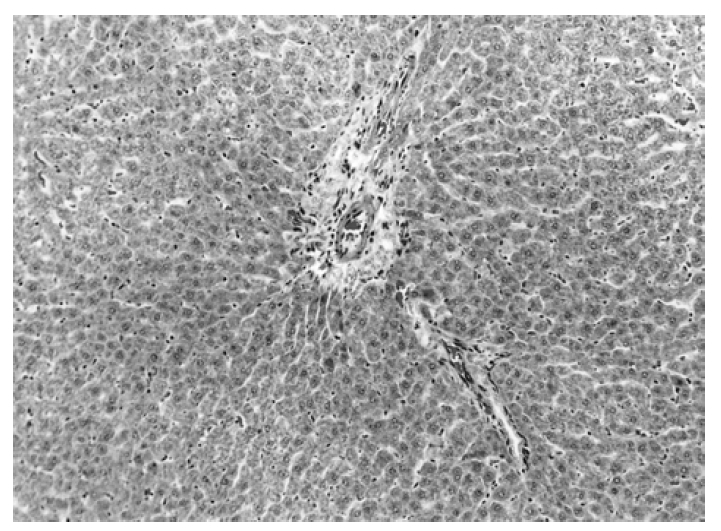
Figure┬Ā5.
The increase of the bile duct proliferation was prominent compared to first week, second week after common bile duct ligation, Masson-trichrome stain, ├Ś100.
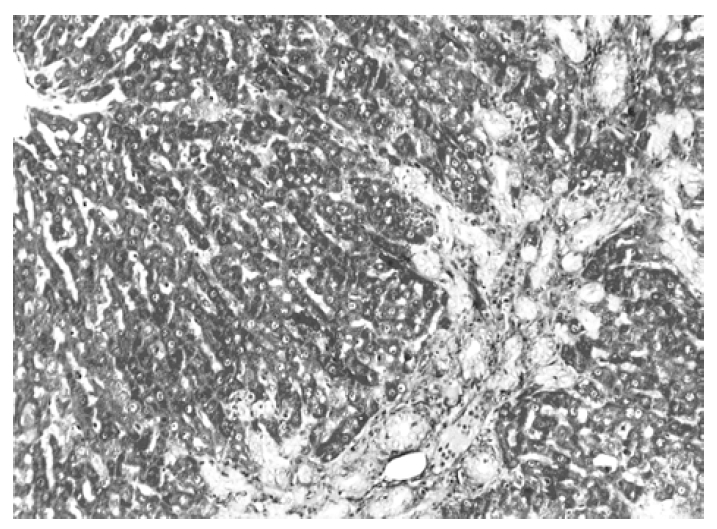
Figure┬Ā6.
Distorted hepatic lobules due to increase of proliferated bile ducts, with inflammatory cell infiltration, fourth week after common bile duct ligation, H&E stain, ├Ś100.
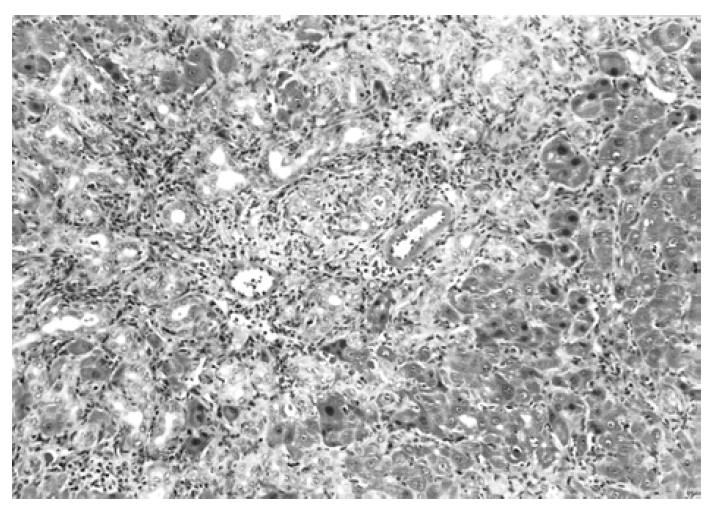
Figure┬Ā7.
Portal-portal or portal-central areas are connected by proliferated bile ducts, and hepatic lobular structures are distorted, sixth week after common bile duct ligation, Masson-trichrome stain, ├Ś40.
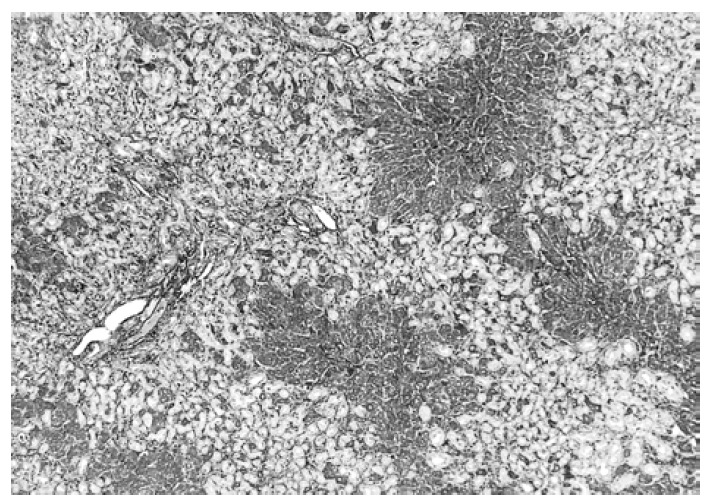
Figure┬Ā8.
Most hepatic lobular areas are replaced by proliferated bile ducts and fibrous tissues (a feature of secondary biliary cirrhosis), Masson-trichrome stain, eighth week after common bile duct ligation, ├Ś100.
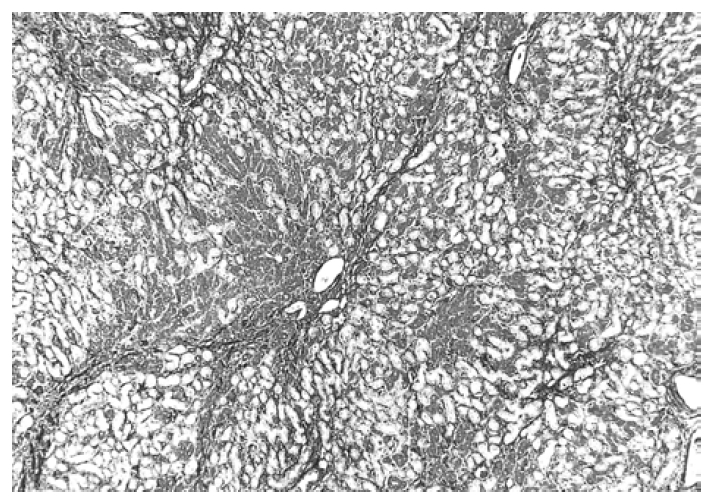
Figure┬Ā9.
Normal portal areas were preserved. Hepatic artery, bile duct and portal vein were stained with alpha-smooth muscle actin. Control group, alpha-smooth muscle actin immunohistochemical stain.

Figure┬Ā10.
Focal necrotic area in the hepatic lobule was found and alpha-smooth muscle actin stain was positive in some areas, second week after common bile duct ligation, alpha-smooth muscle actin immunohistochemical stain.

Figure┬Ā11.
Normal hepatic lobular areas are replaced by proliferated bile ducts. Areas of positive stain with alpha-smooth muscle actin were prominent compared to fourth week, sixth week after common bile duct ligation, alpha-smooth muscle actin immunohistochemical stain.
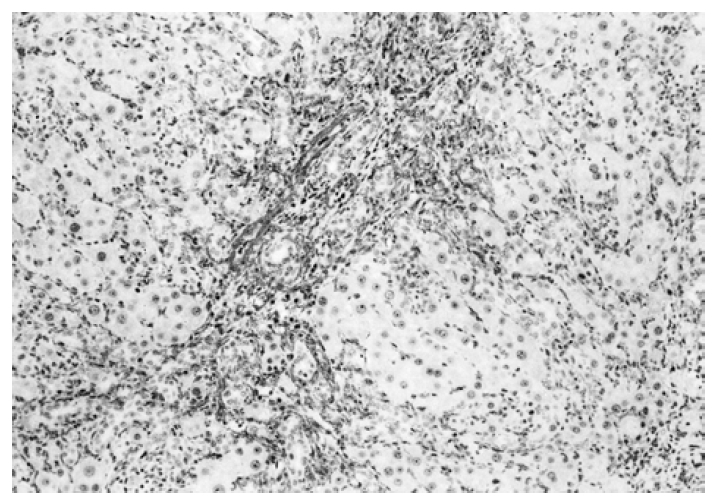
Figure┬Ā12.
Most hepatic lobular areas are replaced by proliferative bile ducts and fibrous tissue. Alpha-smooth muscle actin was stained in proliferative periductular areas, eighth week after common bile duct ligation, alpha-smooth muscle actin immunohistochemical stain.

Table┬Ā1.
Characteristics of Experimental Rats (Mean┬▒SD)
Table┬Ā2.
The Changes of Serum Enzyme Values
Table┬Ā3.
Changes of Serum Cytokine Values (Mean┬▒SD)
REFERENCES
1. Choo KR, Kim GR, Chung YH, Lee YS, Suh DJ. Serologic profiles for hepatitis B virus infection of Korean adults in the late 1990s : survey data of 77, 363 health screener. Korean J of hepatology S 9(A):1998.
2. Seo KS, Lee BS, Sung JK, Lee SW, Kim SH, Kim NJ, Lee HY. The causes and complications of liver cirrhosis during the recent 5 years. Korean J of hepatology 3:202ŌĆō2091997.
3. Statistics in cause of death 2000. Korea National Statistical Office(on-line search).
4. Brenner DA, Rippe RA, Rhodes K, Trotter JF, Breindl M. Fibrogenesis and type I collagen gene regulation. J Lab Clin Med 124:755ŌĆō7601994.

6. Friedman SL. Cytokines and fibrogenesis Progress in liver diseases. Philadelphia: W.B. Saunders, 1999.
7. Sporn MB, Roberts AB, Wakefield LM, Assoian RK. Transforming growth factor-beta: Biological function and chemical structure. Science 233:532ŌĆō5341986.


8. Sporn MB, Roberts AB, Wakefield LM, De Crombrugghe B. Some recent advances in the chemistry and biology of transforming growth factor-beta. J Cell Biol 105:1039ŌĆō10451987.



9. Wang SC, Tsukamoto H, Rippe RA, Schrum L, Ohata M. Expression of interleukin-10 by in vitro and in vivo activated hepatic stellate cells. J Biol Chem 273:302ŌĆō3081998.


10. Tsukamoto H. Is interleukin-10 antifibrogenic in chronic liver injury? Hepatology 28:1707ŌĆō17091998.


11. Matsumara Y, Sakaida I, Uchida K, Kimura T, Ishihara T, Okita K. Prolyl 4-hydroxylase inhibitor (HOE 077) inhibits pig serum induced rat liver fibrosis by preventing stellate cell activation. J Hepatol 27:185ŌĆō1921997.


12. Conn HO, Atterbury CE, Schiff L, Schiff ER. Disease of the liver volume 1. 8th ed. 371ŌĆō385Philadelphia: JB Lippincort company, 1993.
13. Cotran RS, Kumar V, Robbins SL. Robbins pathologic basis of disease. 6th ed. Philadelphia: WB Saunders, 1999.
14. Pinzani M. Hepatic stellate(lto) cell: expanding rotes for a liver-specific pericyte. J Hepatol 22:700ŌĆō7061995.


15. Lee KS. Pathogenesis of hepatic fibrosis. Liver cirrhosis. 1st ed. Seoul: Gun Ja press, 27ŌĆō421995.
16. Czaja MJ, Weiner FR, Flanders KC. In vitro and in vivo association of transforming growth factor-beta 1 with hepatic fibrosis. J Cell Biol 108:2477ŌĆō24821989.



17. Mc Guire RF, Bissell DM, Boyles J, Roll FJ. Role of extracellular matrix in regulating fenestrations of sinusoidal cells isolated from normal rat liver. Hepatology 15:989ŌĆō9971992.


18. Castilla A, Prieto J, Fausto N. Transforming growth factor ╬▓1 and ╬▒ in chronic liver disease. N Engl J Med 324:933ŌĆō9401991.


19. Nakatsukasa H, Evarts RP, Hsia CC, Thorgeisson SS. Transforming growth factor ╬▓1 and type 1 collagen transcripts during regeneration and early fibrosis of rat liver. Lab Invest 63:171ŌĆō1801990.

20. Border WA, Noble NA. Transforming growth factor beta in tissue fibrosis. N Engl J Med 331:1286ŌĆō12921994.


21. Lee Jl, Lee KS, Chung JP. The changes of transforming growth facto-╬▓1 expression and effect of vitamin E in the acute rat liver injury with carbon tetrachloride. Korean J of hepatology 6:147ŌĆō1552000.
22. Grewe M, Gausling R, Gyufko K, Hoffmann R, Decker K. Regulation of the mRNA expression for tumor necrosis factor-alpha in rat liver macrophages. J Hepatol 20:811ŌĆō8181994.


23. Thompson KC, Fallowfield J, Gentry J, Sheron N. Effects of interleukin 4, interleukin 10 and interleukin 13 on production of TNF alpha by rat Kuffer cells(Abstract). Hepatology 24:329A. 1994.
24. Reitamo S, Remitz A, Tamai K, Uitto J. Interleukin-10 modulates type 1 collagen and matrix metalloprotease gene expression in cultured human skin fibroblasts. J Clin Invest 94:2489ŌĆō24921994.



25. Kennedy MK, Torrance DS, Picha KS, Mohler KM. Analysis of cytokine mRNA expression in the central nervous system of mice experimental autoimmune encephalitis reveals that IL-10 mRNA expression correlates with recovery. J Immunol 149:2496ŌĆō25051992.

26. Tompson K, Julia M, Jon F, Martin M, Harry MS, Nick S. Interleukin-10 expression and function in experimental murine liver inflammation and fibrosis. Hepatology 28:1597ŌĆō16061998.


27. Louis H, Jean-Luc VL, Wei W, Quertinmont E, Degraef C. Interleukin-10 controls neutrophilic infiltration, hepatocyte proliferation and liver fibrosis induced by carbon tetrachloride in mice. Hepatology 28:1607ŌĆō16151998.





 PDF Links
PDF Links PubReader
PubReader ePub Link
ePub Link Full text via DOI
Full text via DOI Download Citation
Download Citation Print
Print



